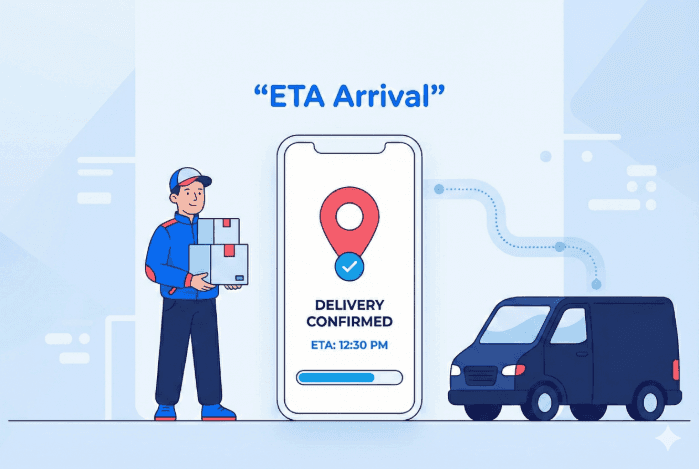In today’s delivery world, everyone wants to know one thing: what’s the ETA? Whether you’re waiting for a package or managing a fleet, the estimated time of arrival drives expectations. This guide explains ETA meaning in business, how it’s calculated, why it matters in logistics, and how it differs from ETD.
We’ll also explore how accurate ETAs can boost business performance, especially in same-day operations, and the tools (like live tracking and shareable links) that make ETA updates more trustworthy. By the end, you’ll see clearly why tracking ETA is crucial, and how solutions like Airpals make it easier than ever.
Table of Contents:
- What is Estimated Time of Arrival (ETA)?
- How ETA Is Calculated?
- ETA vs ETD: Key Differences
- How the Estimated Time of Arrival Affects Business Performance
- Managing Estimated Time of Arrival in Same-Day Operations
- Key Takeaways
- Conclusion: Estimated Time of Arrival Made Clear with Airpals
- Frequently Asked Questions (FAQs)
What is Estimated Time of Arrival (ETA)?
The estimated time of arrival (often shortened to ETA) refers to the predicted time when a shipment, vehicle, or person is expected to reach its destination. In logistics and shipping, it’s a crucial metric used to plan operations, allocate resources, and set customer expectations.
So, what does ETA stand for? It stands for Estimated Time of Arrival, an industry-standard term used across shipping, aviation, and transportation. Similar terms like estimated arrival, ETA estimated, or ETA expected time, all describe the same concept: the projected delivery or arrival moment.
An ETA is an estimate, not a guarantee. It’s based on current information, and real-world conditions can change. While the actual time of arrival (ATA) might differ, having an ETA is still far better than having no idea when something will show up.
ETA in Shipping and Logistics: Why It Matters
Why is ETA important for your business? In logistics and supply chain operations, a reliable ETA isn’t just a “nice-to-have,” it’s mission-critical. Knowing when a shipment will arrive allows end-to-end transparency and efficient planning for everyone involved.
Both the sender (like a supplier or warehouse) and the receiver (like a retailer or end-customer) use the ETA for delivery to coordinate their next steps. For instance, a factory awaiting raw materials can plan production schedules around the incoming goods, and a store can schedule staff to unload a truck at its estimated time of arrival.
How ETA Is Calculated?
The ETA depends on three main factors: distance, speed, and possible delays along the route. It’s typically calculated by combining departure time with the expected travel duration.
A simple formula is: Time = Distance / Speed. For example, if a truck leaves a warehouse at 8:00 AM and travels 80 miles at an average of 40 mph, the ETA would be 10:00 AM.
Modern logistics systems consider many factors when computing the ETA expected time of a delivery:
- Distance and speed: Longer routes and slower transport modes naturally extend arrival times.
- Route and traffic: Congestion, detours, or road type can delay the ETA arrival.
- Stops and delays: Loading, unloading, or multiple drop-offs add to total travel time.
- Weather and conditions: Rain, snow, or road construction can slow transit.
- Mode of transport: Trucks, ships, and airplanes have different speeds and potential delays.
- Real-time updates: GPS tracking and AI-driven tools now refine ETA estimated values on the fly, using live data to close the gap between estimated and actual arrival.
ETA vs ETD: Key Differences
While ETA focuses on when something will arrive, ETD looks at when it will depart. Understanding the difference between ETA vs ETD helps avoid confusion in scheduling and communication.
- ETA (Estimated Time of Arrival): The predicted time of delivery or arrival.
- ETD (Estimated Time of Departure): The planned time when a shipment or vehicle leaves the origin.
Sometimes, the acronym ETD is also used to mean Estimated Time of Delivery, referring to when a shipment will be delivered to the end recipient. This dual meaning can be confusing. To keep it straight, it helps to look at context:
ETA vs ETD Examples
- Departure vs Arrival: Imagine a freight truck is scheduled to leave a distribution center at 6:00 AM. That ETD (departure) is 6:00 AM. If the journey to the retail store is expected to take 4 hours, the ETA at the store would be 10:00 AM.
- Delivery completion example: A delivery van arrives at 2:00 PM, which is the ETA, when it reaches the destination. The driver then unloads, signs paperwork, and hands over the package by 2:15 PM. That final handoff time can be considered the estimated time of delivery (ETD).
In summary, ETA and ETD are closely linked but serve different needs. A smooth logistics operation tracks ETA vs. ETD at each stage, knowing when things leave and when they’re supposed to arrive at their destination.
How the Estimated Time of Arrival Affects Business Performance
The estimated time of arrival plays a bigger role in business performance than most teams realize. It’s an operational indicator that reflects efficiency, reliability, and customer trust. When ETA accuracy improves, so does nearly every performance measure connected to logistics and service quality.
The table below highlights how ETA accuracy as an operations KPI influences key business areas:
| Focus Area | Description | Why It Matters |
|---|---|---|
| ETA accuracy as an operations KPI | Tracks how closely the estimated time of arrival matches the actual delivery time. | Higher ETA accuracy improves efficiency, planning, and overall service reliability. |
| Customer satisfaction | Reliable estimated arrival updates reduce uncertainty and build confidence. | Meeting ETAs consistently enhances retention and reduces support tickets. |
| Operational efficiency | Teams use ETA for delivery data to optimize resources and routing. | Streamlined workflows lower costs and prevent idle time. |
| Business reputation | Delivering on or before the promised ETA reinforces trust. | Consistent on-time performance strengthens brand credibility. |
Managing Estimated Time of Arrival in Same-Day Operations
Same-day delivery operations are perhaps where ETA management is most challenging and critical. Imagine a local courier service promising delivery within a few hours; there’s very little margin for error. In such scenarios, couriers must continuously juggle incoming orders, traffic conditions, and driver availability to meet promised ETAs.
This is where real-time tracking and accurate estimated time of arrival updates become essential for keeping operations predictable. Airpals’ same-day courier services follow this approach, managing the estimated time of arrival with precision and clarity. From order confirmation to final delivery, both the sender and the recipient receive real-time updates that keep expectations aligned.
Live ETA updates users can trust
Airpals keeps everyone informed with live ETA updates throughout the delivery process. Once a shipment is on the way, both the sender and the recipient receive SMS notifications when the driver is about 10 minutes from the destination. This small but powerful update helps teams prepare for the delivery and gives customers the confidence that their order is truly on its way.
In same-day shipping, every minute matters. By communicating the estimated time of arrival proactively, Airpals eliminates guesswork and reduces unnecessary “Where is my package?” inquiries. Transparency builds trust, and trust turns one-time deliveries into long-term relationships.
Shareable Tracking Links
To make tracking even easier, every Airpals order includes a shareable tracking link with live status updates and an accurate estimated arrival time. These links can be viewed and shared by both internal teams and final recipients, giving everyone real-time visibility into where the driver is and when they’ll arrive. For businesses and team users, this visibility translates into smoother coordination and provides peace of mind. Instead of waiting in uncertainty, they can see their package approaching in real time. This combination of ETA accuracy and clear communication is what makes Airpals’ same-day delivery stand out; it turns a stressful waiting period into a seamless, predictable experience.
Key Takeaways
- ETA (Estimated Time of Arrival) helps businesses plan, allocate resources, and deliver with precision.
- ETA calculation depends on distance, speed, and real-time factors like traffic or weather.
- Tracking ETA improves efficiency, transparency, and customer satisfaction.
- ETA vs ETD: ETA refers to arrival, while ETD stands for Estimated Time of Departure, the moment a shipment leaves its origin.
- Business performance: Accurate ETAs boost on-time rates and strengthen operational reliability.
- Airpals Same-Day enhances ETA management through live updates and shareable tracking links, keeping both senders and recipients informed every step of the way.
Conclusion: Estimated Time of Arrival Made Clear with Airpals
ETA doesn’t have to be a mystery. As we’ve explored, demystifying the estimated time of arrival can transform how businesses operate and how users perceive their service. It’s all about communication and accuracy.
At Airpals, we know that timing defines great service. Our Same-Day Delivery solution helps businesses move packages across the city with speed, precision, and full visibility. From order confirmation to live estimated time of arrival updates and shareable tracking links, every delivery is built around transparency and reliability.
Whether you’re sending documents, products, or client gifts, Airpals makes same-day shipping effortless and dependable. Create your first same-day order with Airpals in NYC, Miami, Boston, and 100+ U.S. cities and experience a faster, more reliable way to ship for your business.

Frequently Asked Questions (FAQs)
What does ETA stand for?
ETA stands for Estimated Time of Arrival. It’s an acronym used to indicate when someone or something (like a vehicle or shipment) is expected to arrive at a destination.
What is the ETA meaning in shipping?
The ETA meaning in shipping refers to the date and time a shipment is expected to reach its final destination (such as a port or delivery address). It’s a crucial piece of information for logistics planning, as it helps the recipient prepare for the arrival.
What does ETD stand for, and how is it different from ETA?
ETD (Estimated Time of Departure) is the scheduled time a shipment or vehicle leaves its origin. The difference between ETA vs ETD is simple: ETA refers to arrival time, while ETD marks departure time. ETA tells you when something will arrive; ETD shows when it begins its journey.
How is ETA calculated in logistics?
The estimated time of arrival is calculated using the ETD (Estimated Time of Departure) plus travel time, based on distance, speed, and factors like traffic, weather, or stops. Modern parcel logistics software refines the ETA in real time with GPS data, keeping predictions accurate as conditions change.
Why is tracking ETA important for businesses?
Tracking ETA helps businesses plan resources, schedule staff, and maintain smooth operations. Accurate ETAs improve coordination, reduce downtime, and strengthen reliability across teams. Consistent on-time performance builds trust and avoids costly delays or penalties.
What is the definition of ETD in logistics?
ETD (Estimated Time of Departure) marks when a shipment or vehicle is scheduled to leave its origin. It’s the starting point used to calculate the ETA. Knowing the ETD keeps logistics teams aligned and ensures accurate delivery planning.




